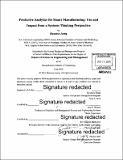Predictive analytics for smart manufacturing : use and impact from a systems thinking perspective
Author(s)
Jeong, Hyunsoo
DownloadFull printable version (16.00Mb)
Other Contributors
Massachusetts Institute of Technology. Engineering Systems Division.
Advisor
Roy E. Welsch and Natasha Markuzon.
Terms of use
Metadata
Show full item recordAbstract
The manufacturing industry has, recently, been facing tremendous challenges, including cost efficiency, system safety, and process automation, and manufacturing companies are required to adopt new technologies to keep themselves sustainable in the fast-changing world of technology. This research focuses, in particular, on how to prevent cutting tool failures and catastrophic accidents in Computerized Numerically Controlled (CNC) machining processes by using a predictive model based on the cutting sound data. With advances in machine learning algorithms and predictive analytics techniques, it becomes possible to create a noise-robust predictive model from an unstructured dataset of sound data. It is an obviously desirable decision to make use of every technology as required and benefit from it. The predictive model introduced in this research uses cutting sound data rather than acoustic emission or force/torque sensor data, which have been widely used for machine failure detection but have shown some limitations. The model is an important stepping stone for realizing an unmanned and fully automated manufacturing system, the so-called "smart factory," and it would be a meaningful movement for the government side as well, taking into account government's responsibility to keep people safe in the workplace. In this research, several experiments were carried out to collect sound data in the CNC machining center in Korea, and particular features were extracted from the analog waveform signals, using the unstructured data to make the predictive model using various advanced data analytics techniques and cutting-edge machine learning algorithms. Then, several analysis methods with systems thinking were used to explore potential impacts of the predictive model on the manufacturing system because the systems thinking approach is the most effective way to analyze a wide range of potential impacts from a holistic perspective. Specifically, the impact analysis was successfully conducted by using a "Causal Analysis based on STAMP (CAST)," which is a system safety analysis method. Also used was "system dynamics modeling," which is generally employed to identify dynamic behaviors in a complex system. Finally, a "complete value template" was constructed to portray how the new system delivers value to its stakeholders from a system architecture perspective.
Description
Thesis: S.M. in Engineering and Management, Massachusetts Institute of Technology, School of Engineering, System Design and Management Program, Engineering and Management Program, 2016. Cataloged from PDF version of thesis. Includes bibliographical references (pages 115-122).
Date issued
2016Department
Massachusetts Institute of Technology. Engineering and Management Program; System Design and Management Program.Publisher
Massachusetts Institute of Technology
Keywords
Engineering and Management Program., System Design and Management Program., Engineering Systems Division.